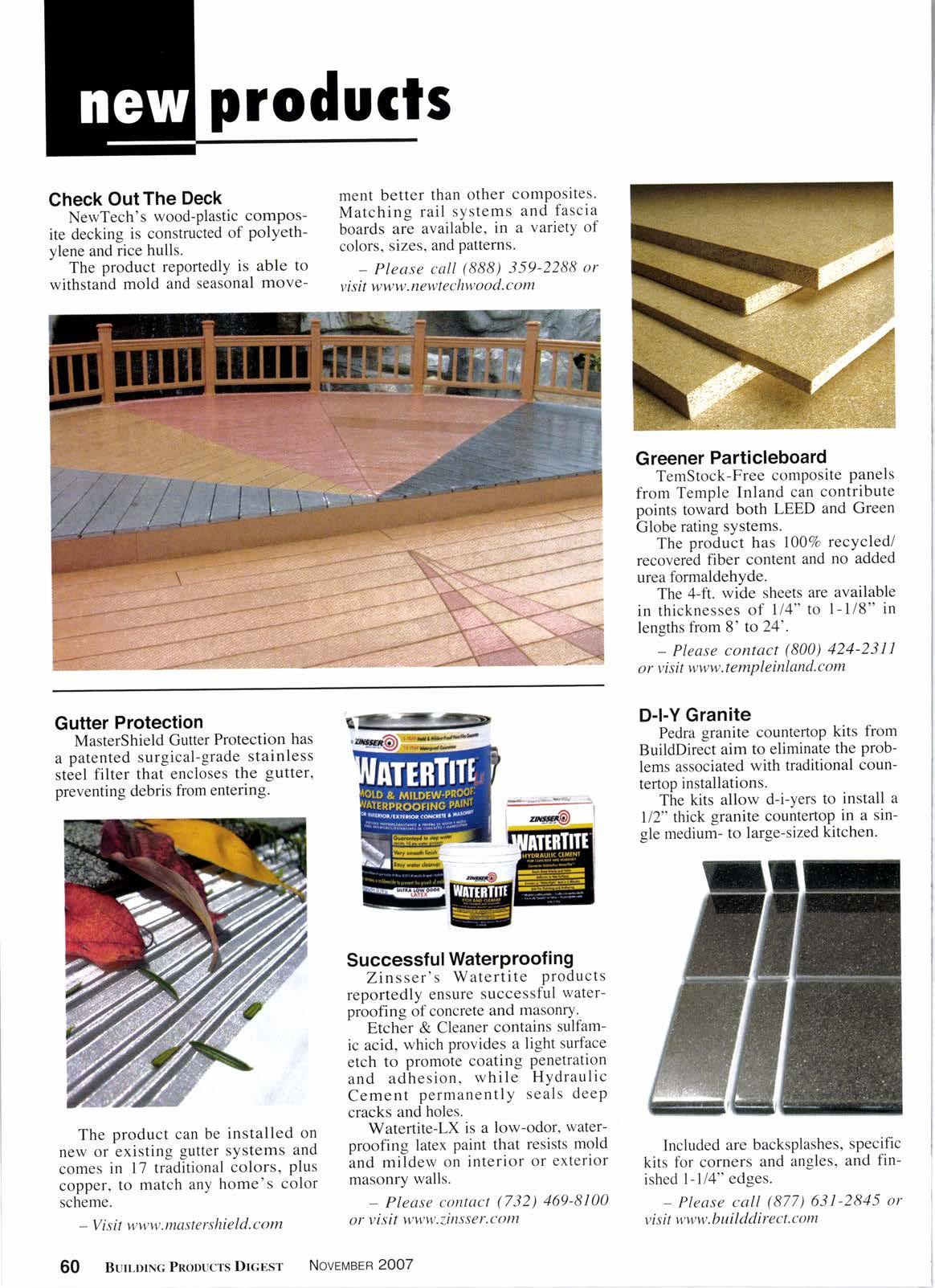
3 minute read
Ihe more rolorful world of d wood
Arch's new organic, Wolmanized L3, is naturally colorless, but is available in several different shades. "It is up to treaters what color they wish to add to the preservative in WolmanizedL3 wood," said Arch's Huck DeVenzio. "Some will probably stay colorless, particularly if they supply manufacturers of gazebos or furniture. My unofficial notion is that a cedar brown color is currently most popular, but there is also a slightly greenish color and, I think, a slightly redwoodish color."
Similarly, Viance's organic Ecolife can be purchased with a natural wood appearance or with added colorant, marketed under the Ecostyle brand.
But even wood treated with copperbased chemicals is beginning to get more colorful. Since its copper particles are micronized, Osmose's MicroPro treated wood is much clearer and lighter than is associated with ACQ, CA and CCA.
GOODBYE,
Wood preservatives with no copper content, such as Wolmanized L3 wood (above), are offered in a range of natural colors.
EtoR years. it's been relatively easy L' to identifv one's treated wood inventory by a quick glance across the yard. Stacks of green usually meant pressure treated.
Because treated wood's copper content is responsible for its greenish color, the industry's conversion from CCA to "next generation" preservatives such as ACQ and copper azole didn't eliminate the green color, so much as it introduced a wider range of greens, from light greenish brown to dark olive.
But the increasing popularity-and growing number- of specialized-use chemicals, many of which contain no copper, are turning treated inventories into a veritable rainbow.
Most of the chemicals themselves are. in fact. colorless. And customers seem to prefer a natural wood look, finding it both aesthetically pleasing and easier to paint and stain.
But treaters realize that the lack of color could have a downside. If all wood looks the same, it's potentially easier to mix inventories between treated and untreated (and between woods of differing treatments). And, customers might doubt whether the wood has been adequately treated-or treated at all.
Consequently, treaters are adding colorant to the treating solution for identification purposes. Most commonly, wood preservers using borates add a blue dye during the treating process. Most fire retaradant treated wood is colored reddish brown. (Arch Wood Protection is currently changing its FRTW from light red to orange.)
Mold treatments run the gamut. Arch's FrameGuard is green. Perfect Barrier's Bluwood is blue. Viance's QuanTIM is purple.
Consequently, said Osmose's Tom Horvat, "it shows the woodgrain pattern better and provides customers with a fresher looking treated wood product. Another benefit to the wood's lighter color is improved painting and staining. Response by builders, architects, designers and do-it-yourselfers has been overwhelmingly positive."
In addition, Osmose has developed MicroShades, a process for micronizing iron oxide pigments. The MicroShades color system is combined with the MicroPro treating solution to produce fencing, deck boards, and deck rail systems in popular consumer colors, such as cedar honey/brown and redwood red/brown.
"Our wood treating customers can produce a MicroPro treated fence picket that is warranted for 15 years against rot, fungal decay, and termite attack," Horvat said. "In addition, the MicroShades color system offers the added benefit of longer lasting color when compared to natural cedar and redwood, which turn silvery gray over time."
wflT#: *T HXffi:1X.1i:'"i: ::; PVC
decking.
composite deck expanding into
This year alone, five companies have introduced alternative-decking products manufactured wholly from PVC: Trex, Azer, Fiber Composites, Gossen, and L.B. Plastics.
Trex's entry into non-composite decking was accomplished through a recent partnership with Vera Innovations, a leader in PVC blending and extrusion technology. "Our research revealed a segment of the market that's seeking a high performance, lower maintenance decking option," said Richard McWilliams, v.p.-marketing. "Trex Escapes addresses these needs."
He added that the new line of decking and fascia is lightweight and easy to install. It also resists stains, molds, and scratches, and can be easily cleaned with just soap and water. The woodgrain decking will be available next January in three colors: gray, beige, and brown. Fascia will be available in matching colors, plus white.
Fiber Composite is another composite manufacturer that is introducing a cellular PVC product. "We were one of the first to manufacture vinyl-wood products in the late 1990s," said president Doug Mancosh. "Fifty percent of our platform has been PVC-based since the company began."
Named Sanctuary, the new product will be available next month. The PVC core is covered by ASA plastic, a










